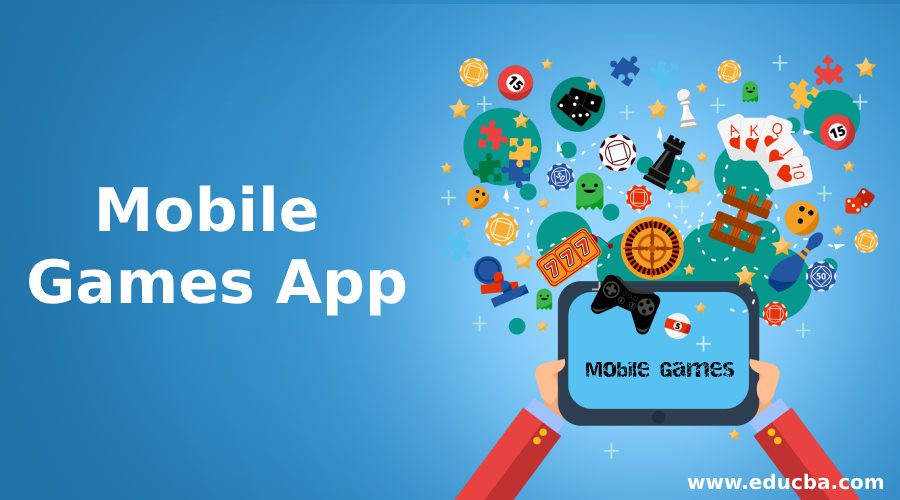Updated April 15, 2023

Introduction to Mobile Games App
There are several developers who have developed ambitions to create a mobile game app. Building a mobile games app, as you are familiar with, is a special kettle of fish and necessitates detailed coding for all features of the game at all stages. While it is intricate to develop code for the mobile games app, it is indeed a rewarding experience for the developers. While building your new game, you should first decide on what type of mobile game app you need to develop.
There are different categories of games that you know. You must choose the category as well as the type of audience you need to target with the game. Determine whether you prefer strategy, RPG, or action. You should also decide whether you want to attract a more intellectual group of corporate or the teen population. Only when you select your type of game you will be able to study the available resources to create code for the same.
You must then decide about the programming language you are going to use for your first mobile games app. Typically, Brew or J2ME can assist you hugely in your ambitious venture. You can refer to J2ME for more resources on programming for mobile game apps. Find conversant with the language of your own choice and comprehend all its functionalities, intricacies, and device support that it renders. Also, try working with the APIs which the language provides.
When you are interested in building a 3D kind of game, you may even try out JSR184 and many others. Keep in mind that experimenting is the key to success. Pay attention to devise specifications by getting to know about the device on which you intend to develop the game. It is imperative that you comprehend all the mobile devices’ specifications, like speed and processor type, resolution and display type, screen size, audio-video format, image format, and so on.
The mobile games app design is a highly essential factor for creating a mobile game app. You need to first plan the general game design and architecture and consider the multifarious features your game includes. You may begin by designing the game architecture for the game engine class. If you are not sure and have doubts about any part of the design, you can better visit mobile gaming forums online and place your queries there. Even a little lapse would make you move back to the beginning from the roots.
Learn everything you have to know about the mobile game’s programming. Reading books and taking active participation in gaming forums is the best way to gain gaming knowledge. Speak with experts in the field to better understand the system as a whole. You may be ready to fail initially at a few attempts. Understand that there are few game developers who succeed in their very first attempt at coding. You would probably need to recode many times before you are satisfied with your work.
Tips for Building Your Mobile Games App
- Develop a detailed storyline and the various play modes for your game much earlier that will aid you in planning the complex details of your game at a later stage. Hence, you should never ignore this stage.
- Create a program skeleton using game programming tools like GameCanvas. This comes with an effective base class that is particularly useful for 2D game developers who are using J2ME.
- Try using the emulator to test your game before releasing it. In fact, you cannot always rely on the emulator alone. In such cases, you want the same mobile device model for checking the game out. You can also outsource it to any other company for testing your game. In general, it would be the best idea to know mobile game programming on the Nokia series 60 phone.
- Despite your best efforts, there are a few times when you need to take your hands off and stop programming. Instead, assess where you went wrong in the coding and break the problem into small bits to make it easy for you.
Different Levels of Mobile Games Development Tools
If developing a game is itself a game, then it comprises four levels, which include planning, prototyping, developing, and releasing. Like a video game, every level is more difficult than the previous one. Every level also has its own obstacles that you are liable to come up with and also its own eventual boss that signifies while you are set to proceed to the next level. You can successfully create your first game if you walk through each level of the game properly.
1st Level: Plan
The foremost level, and obviously the most significant level, is planning. You should plan out all aspects of the game well prior to beginning the coding. The major goal of this level is to take into account everything regarding the game so that you need to improvise then. When you first begin to make your game, the right thing to do is to write down the complete details. Consider everything you need in your game and write it down then. Typically, this is quite simple at first, while your mind thinks about many better ideas you need to integrate into your game.
However, as time passes, this level tends to become increasingly difficult to complete. As you come up with the ideas, also try to prepare the details of every idea, like how they will function, how they will impact the player experience and the way they will influence the gameplay. You do not need to leave any large holes in your design, which will cause you to go through hardship. It will become very difficult to complete a game as the issues you come across the increase. Hence, the secret to complete a game is dealing with problems in lesser amounts and without allowing them to add up all at once.
It is for this reason; it is advisable that you don’t skip out this level and move straight to development, which is level 3. When you do so, you would have to encounter difficult problems, quickly making you feel dominated and eventually quit. If you have experienced playing the Halo series, simply imagine how difficult it would be if you got a hunter pair even during the first level of your playthrough. You need to be hard-pressed to continue playing while you continuously die to these huge obstacles.
It is why the major encounter for this level is a wish to stop planning and start coding. Again, it is significant that you plan as much as you can prior to the coding. In order to have the possibility of completing your first game, you should control this urge and stay at level 1. Questions are the important elements at this level. After reviewing your notes completely and you cannot come up with any further questions, then you are free to step into the next level. In case, however, you read down your notes and still have a few questions on how things work, you must probably work out those prior to moving on.
There are certain times when you cannot be able to answer a question since it deals more with balancing problems instead of functional problems. In such a case, you are probably free to move to the next stage. There are a lot many details that must be planned out well in advance of coding. Due to this reason, it is not recommended to make a text adventure game as the first mobile game. Try to create small at first.
2nd Level: Prototype
(Image source: pixabay.com)The next level of game development involves prototyping. At this point, you should test the core mechanics and game features to work out the balancing issues. You need to flesh out the ideas fast with low-fidelity prototyping so that you can understand what will work and what will not before starting the coding.
When a game is fun and exciting to play at this stage, you know it will also be fun to play after it is completed. Remember that you need to play this game many times as you code it; thus, you would better ensure it is fun. Though this second level, it is very general to prototype ideas as you write them out at the planning level.
The first and second levels can be interchangeable as long as you are not progressing to the third level before you are all set. You may want to test down your core mechanic before spending a long time on details. You perhaps want to test some new features of your game to make sure that it works as intended. All these are proper reasons to prototype as you plan; just make sure that every prototype only pays attention to one thing at a time and that every time you prototype the gameplay, it is yet fun.
There are 2 encounters that you are most likely to encounter at this level. The first is, yet again, the desire to just move to the next level and begin coding. The next encounter will be a wish to develop higher fidelity prototypes. As appropriate as great fidelity prototypes are, they are the difficult path as they improve your wish to begin coding while you are not ready. In order to fight against this battle, consider sticking to fast, rapid throwaway prototypes. You can develop prototypes with no code at all when you utilize beginner-friendly mobile game development tools like Construct 2 or GameSalad.
3rd Level: Develop
The third level is developing, which is quite difficult to complete. Many developers drop their desire and motivation to move further at this level. But no fear! Having the first two levels completed successfully, you must be well on your mobile game development tools.
To start this level, you need to point out which platform you are going to release your game. Whether you are releasing it for Xbox, as a web game, or as a mobile application? After you are decided on your platform, find a programming language or a development engine that could work for this platform.
You can also do this in the reverse form if you feel it is easy with the programming language or development engine. Your platform will be then determined by the potential of your desired language or engine. In order to complete this level, check for the power-ups, such as free game assets, code libraries, and free online resources. Do not reinvent the wheel; employ what is available for free to help you complete this difficult stage.
The major encounter at this level will be discouragement and problems. There are times when you encounter a problem, and you do not know how to solve it. You also become discouraged as you work on your game since it does not meet your greater expectations.
In order to fight against this encounter, you should press on. If you want, take some days to remain away from your game in case you get stuck. This allows your mind to get freshen and have new ideas to enter. Typically, just sleeping on the issue assists you in finding a solution the other morning. Do not work yourself till death. Try to pace yourself so you don’t become discouraged or stressed.
4th Level: Release
(Image source: pixabay.com)The last stage of this game development is release. This stage is not as close as difficult as the third level but is still challenging. For this stage, you have to get people, make them play your game, and offer feedback. According to this feedback, try to make changes that you feel can make the game exciting and fun. The major encounter at this level is managing criticism. There may be people who don’t like your game. Do not allow those people to tear you down simply because they feel the necessity to voice their feedback.
Recommended Articles
This is a guide to Mobile Games App. Here we discuss the introduction, tips to build your mobile games app, and different levels of mobile games development tools. You can also go through our other suggested articles to learn more –





